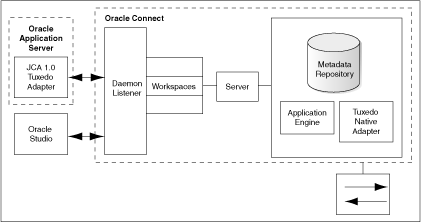| Oracle® Application Server Adapter for Tuxedo User's Guide 10g Release 3 (10.1.3.1.0) Part Number B29000-01 |
|
|
View PDF |
| Oracle® Application Server Adapter for Tuxedo User's Guide 10g Release 3 (10.1.3.1.0) Part Number B29000-01 |
|
|
View PDF |
This section provides an overview of the features and architecture of OracleAS Adapters for Tuxedo.
This section contains the following topics:
OracleAS adapters for Tuxedo includes the following adapters:
These adapters integrate Oracle Application Server with the legacy and mainframe applications. OracleAS Adapters for Tuxedo model services running on the BEA Tuxedo application server. The BEA Tuxedo application server provides two programming interfaces, Common Object Request Broker Architecture (CORBA) and Application to Transaction Monitor Interface (ATMI). ATMI supports a programming interface that offers procedural library-based programming using a set of C or COBOL procedures. ATMI also provides an interface for communication, transaction, and data buffer management. In addition, the ATMI interface and BEA Tuxedo system implement the X/Open distributed transaction processing (DTP) model for transaction processing.
OracleAS Adapter for Tuxedo includes the following features:
Improved performance by providing direct access to the platform where OracleAS Adapter for Tuxedo runs.
Models Tuxedo services as a collection of interactions, where each interaction is mapped to a specific Tuxedo service, along with the input and output records.
Captures and maintains a metadata schema for the Tuxedo system by importing Tuxedo metadata either from FML and VIEW files or from a JOLT file, and transforming this metadata into mapping definitions for Oracle Connect.
Supports Tuxedo/T synchronous calls.
Maps Tuxedo message structures to XML data and back.
Supports local transactions by acting as a Resource Manager (RM). This is achieved by the adapter responding to XML transactional verbs and issuing the corresponding ATMI transactional calls. The back-end service is responsible for the transaction semantics and implementation.
Supports full client authentication with the Tuxedo server. An optional use of username and password is also supported.
Supports the following buffer types:
STRING
VIEW (both 16-bit and 32-bit are supported)
CARRAY
FML (both 16-bit and 32-bit are supported)
XML
MBSTRING (only supported in BEA Tuxedo version 8.1 and higher)
Supports Post events (EventBroker). This enables Java applications to subscribe to Tuxedo events, and receive them as J2CA 1.5 message inflow. Events are posted to one or several queues, according to ruling policies.
Supports writing messages to a queue (enqueue). This is performed by executing the enqueue interaction for which the event is defined as the interaction input record.
OracleAS Adapter for Tuxedo does not support global transactions and cannot participate in a distributed transaction.
See Also:
Oracle Application Server Adapter Concepts Guide. BEA Tuxedo Documentation.OracleAS Adapter for Tuxedo/Q is used for pulling messages from a queue. A queue is referred to as an outbound channel, and it is logically equivalent to an outbound interaction.
To pull messages from the queue, the getEvents interaction is executed. This interaction is automatically added to the adapter schema. When executed, all messages are pulled from the queue. In addition, a record that unions all the output records is created and is being used as the interaction output record.
A selected masseage can be removed from the queue, using the dequeue interaction. When executed, a message with specific attributes is removed from the queue.
The following components comprise the architecture for Oracle AS Adapters for Tuxedo:
J2CA 1.5 Tuxedo adapter: The J2CA Tuxedo adapter is a standard resource adapter that is compliant with J2EE Connector Architecture, providing J2EE components connectivity.
Oracle Connect: Oracle Connect runs on the legacy system and handles requests from the J2CA 1.5 Tuxedo adapter that runs within Oracle Application Server Containers for J2EE (OC4J).
Oracle Studio: Oracle Studio is the configuration tool for Oracle Connect. Configuration tasks using Oracle Studio are performed on a Windows platform. Oracle Studio uses perspectives that enable you to generate specific information necessary to model OracleAS Adapters for Tuxedo.
Figure 1-1 illustrates the components of OracleAS Adapter for Tuxedo.
Figure 1-1 Architecture of OracleAS Adapter for Tuxedo

The J2CA 1.5 Tuxedo adapter converts the J2CA interaction invocation received from an application client to the XML format and passes the XML format to Oracle Connect on the legacy server. The daemon listens for the request coming from the J2CA 1.5 Tuxedo adapter client and assigns a server process to handle the request. The properties of the server process (such as connection pooling requirements) are defined by a workspace definition within the daemon. The server process includes an instance of the application engine, which converts the XML format into native structures understandable by Tuxedo and passes the converted XML to the back-end adapter. The back-end adapter builds an interaction based on the metadata for the back-end adapter stored in the repository and the incoming converted XML and passes it to the legacy application. The results of this execution are passed back to the application engine, using the back-end adapter, where these results are converted to XML and passed back to the client.